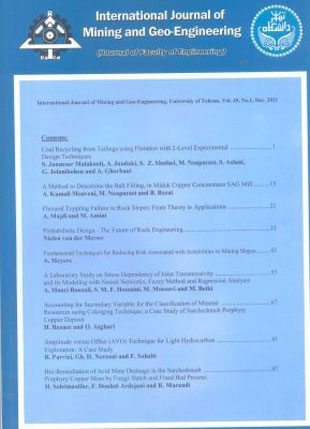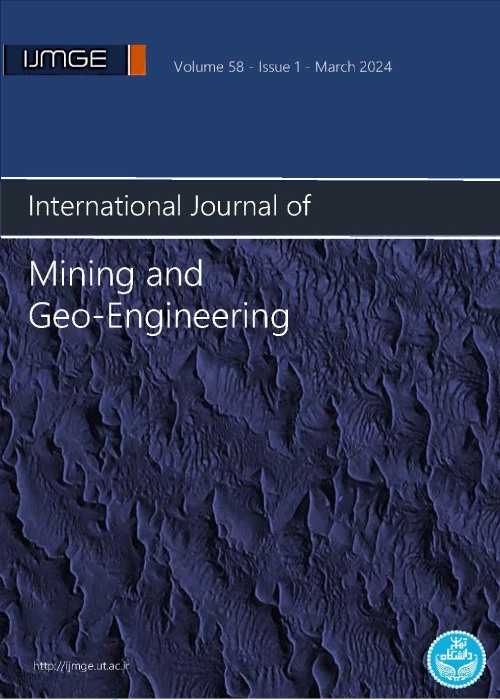فهرست مطالب

International Journal of Mining & Geo-Engineering
Volume:47 Issue: 1, Winter and Spring 2013
- تاریخ انتشار: 1392/06/17
- تعداد عناوین: 7
-
-
Pages 1-11To construct copper heap leaching structures, a stepped heap of ore is placed over an isolated sloping surface and then washed with sulphuric acid. The isolated bed of such a heap consists of some natural and geosynthetic layers. Shear strength parameters between these layers are low, so they form the possible sliding surfaces of the heaps. Economic and environmental considerations call for studying such slides. In this study, firstly, results of the laboratory tests carried on the materials of the heap leaching structures bed are presented. Then, the instability mechanisms of such structures are investigated and proper approaches are summarized for their stabilization. Finally, stability of the Miduk copper heap is evaluated as a case history, and appropriate approaches and their effects are discussed for its stabilization.Keywords: heap leaching structures, Miduk copper mine, shear strength parameters, stability analysis, stabilization
-
Pages 13-32Ground settlement is often the most serious concern when tunneling under an old city with numerous historic monuments. A successful engineering design under these conditions would require getting the most out of the ground strength parameters and avoiding any weakening maneuver throughout the operation. Knowing that surface settlement is highly affected by tunneling parameters in EPB shield tunneling lead us to estimate the optimum values for the machine heading pressure with the lower amount of the ground settlement in fragile structure of the old city for the Esfahan Subway Project. Tunnels were dug underneath some of the most prominent historical sites along the path of the project. To improve precision and efficiency in tunneling operation, at the first step, tunnel heading confinement pressure is calculated by using an advanced 3D mathematical approach based on the limit equilibrium theory. Then, a promoted 3D finite element model is developed, taking into account the tunneling procedures and the designed heading confinement pressure from the first step. Settlements were pre-calculated and the surface displacement was checked at all sensitive locations. At the third step, settlement is estimated by exerting executed face supporting pressure to the tunnel face and the concluded amounts for displacement are compared with the outputs of extensometers. This comparison leads us to check the reliability of calculated settlements and the accuracy of the designed tunnel heading confinement pressure. Furthermore, evaluating the relation between extensometer outputs and executed tunnel face pressure at the points of extensometers stations validates the assumption that the safe face supporting pressure causes least surface displacement. Although the minimum pressure occurred in short term fluctuations, this approach confirms the sensibility of settlement with the least executed face supporting pressure.. It is also found that higher executed face supporting pressures could reduce the tunnel face stability. Therefore, documentation of appropriate software facilitates design procedures. Yet a further achievement of this study concerns effective decision implementations under strictly limited.Keywords: EPB shield tunneling machine, extensometer, heading confinement pressure, numerical modeling settlements
-
Pages 33-40The main rock mass classification systems make use of similar rock mass parameters. Due to lack of comprehensive estimation systems, determining the real specifications of jointed rocks faces some difficulties. A vast number of parameters with various degrees of impact are involved in such definitions. Combination impact of all the effective parameters is to be figured out in order to come up with an acceptable value. Different classification systems have some well-known drawbacks and limitations mainly due to their empirical base. However, they are still very useful in practice. Therefore, there is a need to improve their efficiency. Two of these classification systems are the RMi and the Q-system. Bakhtiari dam site is located in the southwest of Iran. The project area consists of the sedimentary bedrocks of Sarvak and Garau formations. The Sarvak Formation is divided into 7 units from Sv1 (oldest) to Sv7 (youngest). Deviation system of Bakhtiari dam includes two tunnels, namely upper and lower tunnels. In this paper, the result of geological scanning of rock masses in seven geological zones hosting binary tunnels of Bakhtiari dam have been utilized. This information along with data produced from many different laboratory tests have been used to estimate the values of Q and RMi for each of the geological zones. The pros and cons of both systems are revealed and relationships are driven between the two systems through statistical analysis. The paper also shows that there are good correlations between the two systems. Finally, the support details suggested by each system are determined.Keywords: rock mass classification, Q system, RMi system, support system
-
Pages 41-50Edge detection and edge enhancement techniques play an essential role in interpreting potential field data. This paper describes the application of various edge detection techniques to gravity data in order to delineate the edges of subsurface structures. The edge detection methods comprise analytic signal, total horizontal derivative (THDR), theta angle, tilt angle, hyperbolic of tilt angle (HTA), normalised total horizontal gradient (TDX) and normalised horizontal derivative (NTHD). The results showed that almost all filters delineated edges of anomalies successfully. However, the capability of these filters in edge detection decreased as the depth of sources increased. Of the edge enhancement filters, normalized standard deviation filter provided much better results in delineating deeper sources. The edge detection techniques were further applied on a real gravity data from the Gheshm sedimentary basin in the Persian Gulf in Iran. All filters specified a northeast-southwest structural trend. The THDR better outlined the structural morphology and trend. Moreover, it indicated the salt plugs much better than other filters. Analytic signal and THDR successfully enhanced the edges of the shorter wavelength residual structures. Normalized standard deviation (NSTD), TDX and hyperbolic of tilt angle (HTA) filters highlighted the likely fault pattern and lineaments, with a dominant northeast-southwest structural trend. This case study shows that the edge detection techniques provides valuable information for geologists and petroleum engineers to outline the horizontal location of geological sources including salt plugs and stand out buried faults, contacts and other tectonic and geological features.Keywords: local phase filters, real gravity data, salt plug, synthetic model
-
Pages 51-59Cost reduction is one of the methods applied for improving the productivity of organizations. In productivity literature, particularly in nonparametric methods, cost reduction related methods are regarded as input oriented models. This paper presents a Supply Chain Management (SCM) model in which purchasing iron ore and coke from different resources, along with production and distribution of steel products were investigated to improve the productivity of a steel making plant in Iran. The model was designed based on a single objective concept with a focus on total cost minimization. The constraints of the model consisted principal restriction concerning mines, coke plant and products. The model was implemented in steel factories (blast furnace) affiliated with Iranian Mines and Mining Industries Development and Renovation Organization (IMIDRO).The results showed that the priority for providing iron ore should be given to Iran Central Iron Ore Company (ICIOC) which has enough production capacity to satisfy the required ores. The results further suggested that at the best productivity condition, Isfahan steel plant should focus on the beam and bar production. The other plants, i.e. Zagros plant, should focus on L-beam and slab and finally Meibod steel plant should concentrate on slab production. It was also showed that the coke production plants cannot supply the required tonnage of the steel plants. Therefore, some new plants should be established to achieve self-sufficiency in this industry. This model can be used as a support tool for decision-makers at strategic and tactical decision levels.Keywords: Productivity, supply chain management, linear programming, steel industry
-
Pages 61-80Bioleaching processes for extraction of Cu and Mo from molybdenite cons. are more environmentally friendly and consume less energy than conventional technologies, yet less economically efficient. One necessary step towards arriving at a cost-effective bioleaching process is using appropriate methodology to optimize pertinent factors in such processes. To this end, the present study employed Response Surface Methodology to optimize important factors in a molybdenite bioleaching process by mix mesophilic microorganism using shake flasks. The effect of change in the levels of molybdenite concentration, pyrite and silver ion concentration as additives - in the range 3-9%, 1-5%, and 0-1.2gr/l, respectively - on the rate of Cu and Mo bioleaching was studied using a Central Composite Design. The results showed a statistically significant effect of silver ion and molybdenite concentration, and to a lesser pyrite concentration, on the rate of bioleaching of Cu and Mo. Further, different mediums and additives were evaluated for copper and molybdenum extraction from molybdenite concentrate in bioleaching process. Small amounts of silver (100mgr/l AgSO4) dramatically accelerated the copper dissolution process. Addition of FeS2 and sulfur with ferrous sulfate accelerated the acidification and raised the oxidation-reduction potential of solution (medium) with an inoculation of 15% (v/v) of active and adapted indigenous mesophilic bacteria, thus resulting in an overall increase in Mo dissolution efficiency.Keywords: additive, biohydrometallurgy, Cu, Mo dissolution, mixed mesophilic bacteria, modeling, optimization, molybdenite concentrate
-
Pages 81-90The development of yielded or failure zone due to an engineering construction is a subject of study in different disciplines. In Petroleum engineering, depletion from and injection of gas into a porous rock can cause development of a yield zone around the reservoir. Studying this phenomenon requires elasto-plastic analysis of geomaterial, in this case the porous rocks. In this study, which is a continuation of a previous study investigating the elastic behaviour of geomaterial, the elasto-plastic responses of geomaterial were studied. A 3D finite element code (FEM) was developed, which can consider different constitutive models. The code features were explained and some case studies were presented to validate the output results of the code. The numerical model was, then, applied to study the development of the plastic zone around a horizontal porous formation subjected to the injection of gas. The model is described in detail and the results are presented. It was observed that by reducing the cohesion of rocks the extension of the plastic zone increased. Comparing to the elastic model, the ability to estimate the extension of the yield and failure zone is the main advantage of an elasto-plastic model.Keywords: elasto, plastic, FEM, gas injection, plastic zone, porous reservoir


